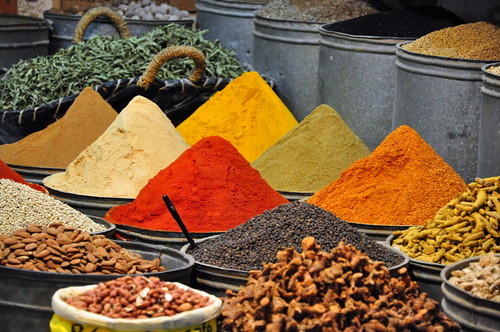The possibilities of blending teas to create new and unique flavors and endless. It can be a great way to add a kick to a tea you’ve already got in your cupboard. I’ve been doing more research and reading on how to blend teas and it’s fun to think about different combinations.

Tea Flavorings
Different varieties of tea can be mixed with all sorts of different flavorings to create new and unique blends. Here are some ideas on what you can mix your tea leaves with.
- Almond extract – a pungent flavoring made by combining bitter almond oil with ethyl alcohol. It should be used sparingly and carefully. Sprinkle onto tea leaves, cover and shake, and let it rest overnight.
- Bergamot is a fruit the size of an orange, with a yellow color similar to a lemon, and a pleasant fragrance. It is native to Italy and is used most commonly for the flavoring of Earl Grey tea. Earl Grey blends bold-flavored black tea with bergamot oil, which gives the tea a slightly flower and sweet citrus aroma.
- Cacao, which is commonly used for cocoa butter and chocolate. Crushed cacao seeds, called nibs or bits, impart flavor. You can also use shavings of chocolate to flavor the tea.
- Cardamom is a member of the ginger family, native to India. The seeds are encased in a pod about the size of a tiny grape, with about twenty seeds per pod. The seeds are ground to a powder that has a sweet and spicy flavor.
- Cassis is an European black current that, when dried, gives tea a delightful berry flavor.
- Cinnamon is the inner bark of a tropical evergreen tree. The bark dries into a curled quill, which is chopped into finger-length pieces and sold as sticks, or ground into a fine powder. The flavor is slightly bittersweet.
- Citrus zest, or fruit peel, is a very popular tea and herbal flavoring. Citrus fruit with tight skin – not bumpy or pocked – will have more citrus oil in the skin, and therefore more flavor. Even if you’re using organic fruit, wash and dry it thoroughly, and cut out any bad spots or discolorations
- Vanilla beans are harvested from the seed pod of orchids native to Mexico. Scrape the seeds out of the pods and dry both. The pods can be brewed with tea, or the seeds can be mixed in with tea leaves to provide a delicate vanilla flavor.
Blending Tea for the First Time
Each type of tea has its unique properties that make them special. For starters, black tea is one of the easiest varieties to blend.

To blend the teas, combine the tea leaves and flavorings into a glass jar with a tight fitting lid. Cover and shake gently to combine well, and then place in a dark, dry, cool place. It helps to keep a journal to record your experiments with how well the teas blend.
Most of my experiments and learnings are inspired by the tea book Tea for You: Blending Custom Teas to Savor and Share. While it’s a short and easy to read book, it contains some fun tea blending and tea cooking recipes as well as interesting tea facts.
I’m also curious about blending tea with jasmine flowers. Jasmine black tea is one of my favorite blends, but it seems like it can’t be blended as a dry extract. According to this article on Wikipedia, jasmine tea is produced by repeatedly mixing tea leaves with fresh jasmine flowers for several hours, and then firing the tea to remove the moisture. Does anyone have any experience with blending teas with jasmine? Does it work with just jasmine extract?
I’ve been having a lot of fun experimenting with some common household spices and herbs. What are your favorite flavor combinations?